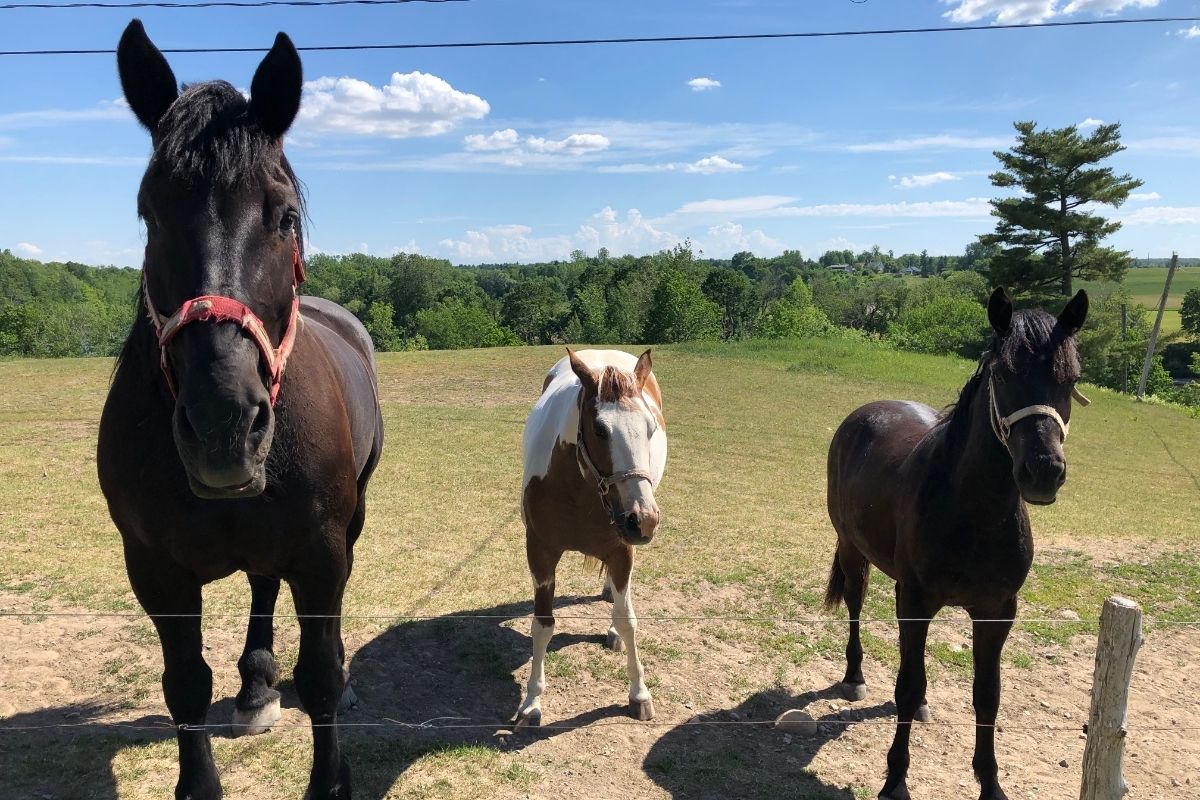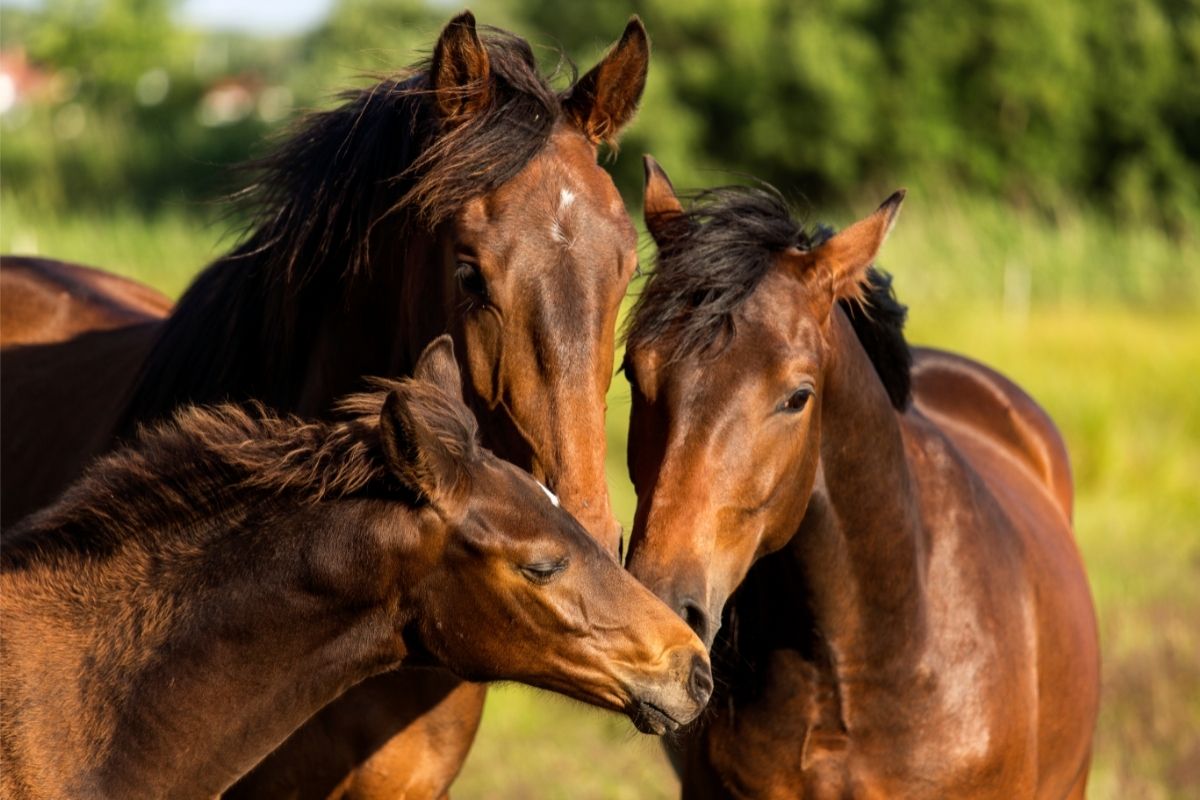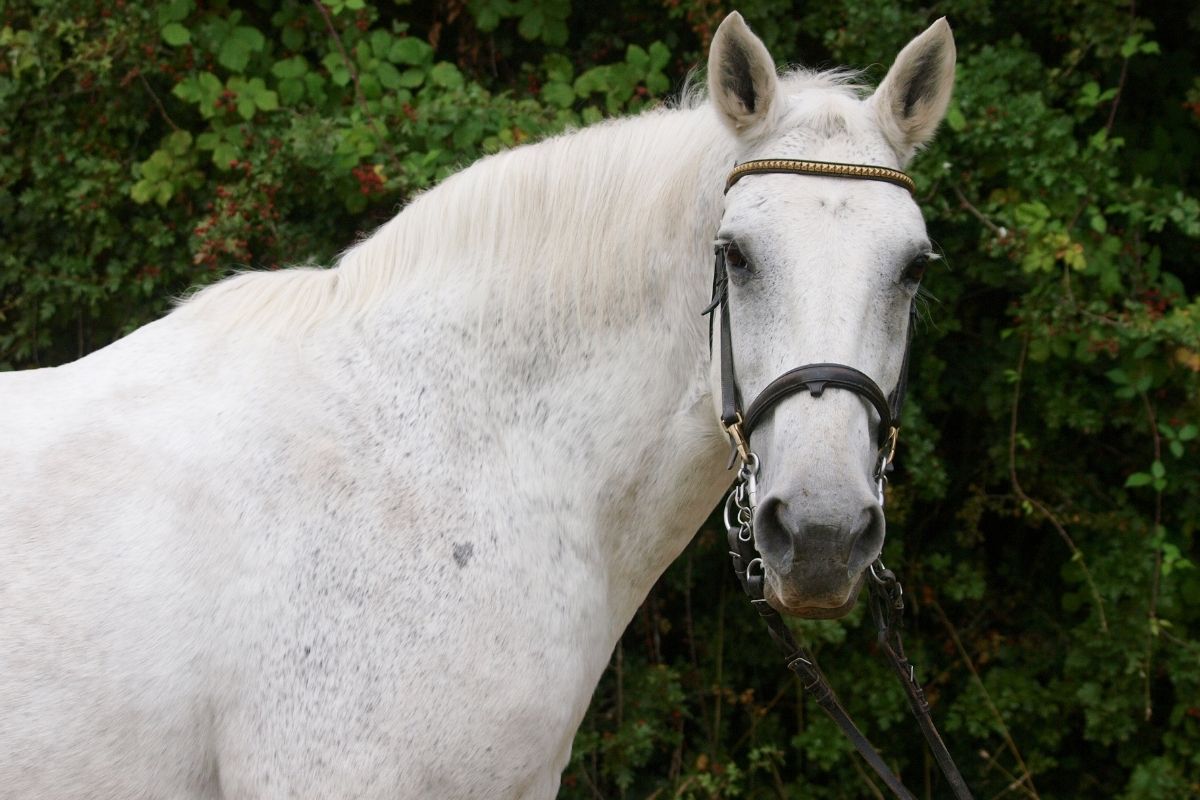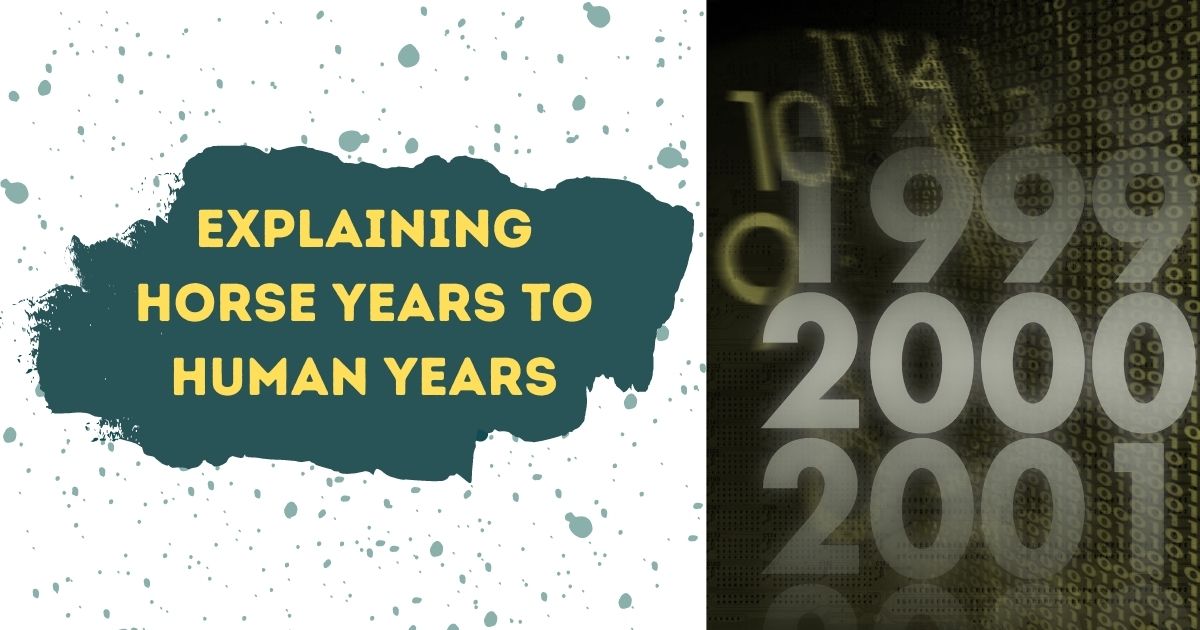How do Horses Age?
You will find a profound fondness for horses from the old to the young, which leads to the curiosity of comparing horse years to human years. The research was done and completed in 2003 by equine veterinarians to compare human ages to horse ages. The research would greatly help compare human to horse years.
How do horses age? Fact is, horses and humans mature and age at very different rates. The comparisons made were simply estimates and should not be taken too seriously.

Horse Years to Human Years – a Chart
The chart below explains how the two compare to try and understand horse years to human years:
| Horse Years | Human Years |
| 1 | 6.5 |
| 2 | 13 |
| 3 | 18 |
| 4 | 20.5 |
| 5 | 23 |
| 6 | 25.5 |
| 7 | 28 |
| 8 | 30.5 |
| 9 | 33 |
| 10 | 35.5 |
| 11 | 38 |
| 12 | 40.5 |
| 13 | 43 |
| 14 | 45.5 |
| 15 | 48 |
| 16 | 50.5 |
| 17 | 53 |
| 18 | 55.5 |
| 19 | 58 |
| 20 | 60.5 |
| 21 | 63 |
| 22 | 65.5 |
| 23 | 68 |
| 24 | 70.5 |
| 25 | 73 |
| 26 | 75.5 |
| 27 | 78 |
| 28 | 80.5 |
| 29 | 83 |
| 30 | 85.5 |
| 31 | 88 |
| 32 | 90.5 |
| 33 | 93 |
| 34 | 95.5 |
| 35 | 98 |
| 36 | 100.5 |
| 37 | 103 |
| 38 | 105.5 |
| 39 | 108 |
| 40 | 110.5 |
Did you know that comparing cat and dog years to humans instead of a horse to human years is easy? The reason is horse years, compared to human years, depend wholly on life expectancy. Ponies or horse years are not based on their birth years. Therefore you will only consider the years of this animal exclusively based on its life expectancy.
When animals and humans reach their entire life span, they will do so at very different rates. The equine is no different. That is why there was a need to establish a horse-to-human years converter. Experts have tried to establish an obvious, straightforward conversion to human years; it’s virtually impossible to get the exact conversion.
When a human is a year old, the foal is 6.5 human years. At two years, the yearling’s human years are 13 years. At this point, the calculation of its age seems clear until the horse reaches three years of age, then it gets a bit complicated.
At three, one horse’s year is equivalent to 2.5 human years. So working with this understanding, how old are horses in human years when they are 5? A 5-year-old horse is the equivalent of a 23-year-old human. The horse’s aging rate slows down at ten years, but it’s still faster than the human aging rate.
This aging rate is maintained for the rest of the horse’s lifetime. At 17 years, your pony is now in the senior class. Therefore, at 17, its horse age in human years is 53, and a 26-year-old horse equates to a senior of 78 years.
What if a 35-year-old horse? It will be the same age as an elderly chap of 98 years. Just as humans who live this long are considered very fortunate, age is incredibly high for a horse, and most don’t get there.
Keep in mind that horses mature at a higher and different rate than humans. For instance, at the age of 1, a human infant can’t even feed itself and is wholly dependent on its parent, whereas a foal will imitate its mother’s nibbling habits moments after birth.
A child can’t walk until they are about one year old, whereas a horse will wobble in its baby steps until it’s stable enough a few moments after birth. They experience factors that affect their growth rate just like humans. It’s therefore vital not to take this very literally because of this.

Which Factors Influence How Old a Horse Gets?
Did you know that ponies mature faster and live longer than horses? Could this be attributed to its size? Or could this advantage be due to its genetic makeup? We shall find out. Growth in horses increases both weight and wither height. A foal experiences rapid weight gain from birth to about 12 months, 50 to 60 percent of mature weight.
The yearling’s weight gain slows down at 36 to 60 months, and your horse has reached mature weight. At 24 months, it has gained 80 to 90 percent of its adult weight 95 percent of wither height. The factors that influence how old a horse gets include the following;
Genetics
Your horse has a particular genetic makeup that determines its growth rate. It limits what exercise or nutrition can achieve in growth rate regarding genes. There is a type of breed known as fact growers and others as slow growers. However, you cannot generalize because of large variations between genetic lines within a breed.
For example, have you noticed how fast racing breeds mature instead of sports horses that develop slowly? Therefore, producers will select for rapid growth because of the high premium they fetch. Most people will go for large yearlings because of their competitiveness in games for young horses.
This kind of selection has come with skeletal disorders, especially as the horse ages. An orthopedic disease of the joint (osteochondrosis) heritability is at a high of 50 percent in some horses’ lines.
However, the disease can be dependent on other management factors. But it may be not easy to document due to variations in management, rate of growth, and leg conformation in horses with similar ancestry. For instance, lameness in young horses is majorly caused by deviations in bone alignment, and as such, they find it hard to stay sound at any growth rate.
Nutrition
Nutrition is all about the ratio and composition of intake and how it alters the rate and composition of your horse. If you offer pelleted diets to your horse, it will have a great average daily gain attributed to the ease of digestion of such foods.
Some people restrict intake to achieve low wither height, but this always steers towards trouble for the horse if you suddenly choose to increase feeding to achieve an abrupt increase in size or condition. Ultimately, weight and wither height will not only deteriorate if you keep up feeding restriction but also inhibit proper skeletal growth later in its life.
You will need to watch out for excess fats in your horse as it creates more weight stress on its legs, hindering its athletic ability. As your horse ages, its muscle and bone growth rate slows down. Therefore a high nutritional plane will lead to the deposition of more fat.
Yearlings in a high nutritional plane require tight intake regulation as they are more susceptible to weight gain than weanlings. High gain rates predispose young horses to disorders like equine gastric ulcer syndrome.
So how much should your horse consume? The exact ratio to promote growth is flexible and somewhat debatable, majorly due to genetic makeup that greatly varies. Some horses are developed at a slower rate than others because of how bone and muscle mature for the coordinated development of both systems.
Maintain your horses in moderate conditions. Therefore, avoiding overfeeding or underfeeding will keep the horse free of nutritionally related leg problems.
Exercise
Research on humans in laboratories has shown that exercise is critical for growth rate determination. The exercise’s type, level, and duration will determine how your horse gains weight and its composition. When it comes to young horses, exercise cannot be overemphasized.
Controlled and forced exercise is critical to strengthening the bone density of the horse. However, his exercise has to be done under serious caution as forced exercise can cause damage to the articular cartilage.
To avoid such damages, subject your foal to free pasture exercise in the first five months, which will help condition their musculoskeletal system and supportive structure of articular or joint cartilage.
What is a stressful and not stressful level of exercise for your horse? The best exercise that promotes sound skeletal muscle is important to determine the level at which exercise becomes too stressful and the type of exercise that best promotes sound skeletal and muscle development. Keep the exercise at low intensity by working your horse slowly.
Stalls vs. Pastures
Where you keep your horse will greatly affect its growth and how fast it gets old. The facility available and your end goal matter in your decision to keep horses in stalls or open pasture. Stalled horses receive individual attention and can easily be well maintained.
Such maintenance includes keeping it in a shorter hair condition. The horses may require stalling and individual care if you plan to show or sell weanlings and yearlings. Access to daily exercise is important.
When stalled, young horses will be provided with a high plane of nutrition and subjected to limited exercise in most cases. Because of this, the owner will be forced to subject them to longer single exercise bouts that are too intense, which will lead to unnatural strides and bone fatigue.
To curb this as a stalled horse owner, you will need to adjust the exercise to suit the developmental needs of your horse. Having said all of the above, isn’t it fun to know whether you could be sharing a birthday with your favorite pony? Remember that comparisons on this chart are not 100 percent accurate.
Horse Life Stages
The life cycle is not very different from humans’. Like you, it begins from birth, then develops to adolescence, adulthood, and old age:
Foal (Birth to Weaning)
The gestation period takes about 341 plus or minus 15 days. They are referred to as foals from birth until they are weaned. After which, they are called weanlings.
Adolescence/Youth (Yearlings and Two-Year-Olds)
A one-year-old horse is called a yearling. Compared to a human, it is 6.5 human years. It has almost attained mature height and a filled-out body frame. This period is marked with different growth periods that make the yearlings look unbalanced. The age of 1 to 4 horse years is known as the horse maturity age.
Their names are gender-based. The female horses are called fillies, while the male ones are called colts. They attain puberty at two to three, and their growth rate greatly slows down. Growth, however, isn’t complete until it reaches 4 to 5 years.
After six months from birth, you will need to geld (castrate) your horse which will help to train and handle the horse easily. Their hormones at this time tend to stay active for long, making them grow taller than intact stallions.
A female horse is then called a mare once it turns four years of age, and a male one is called a stallion or gelding.
Adulthood
At five, the horse will mature and turn to adulthood. Those called warmblood horses will need another year to mature into adulthood as they typically mature at a slower rate. At the turn of adulthood, it’s now ideal for riding and participating in races and shows.
Old Age/Seniors
For horses, old age sets in the late teens and early twenties. These seniors are also referred to as ‘geriatric” horses. At 17 years of age, your pony is referred to as a senior. So how long do horses normally live? At their old age, they have 25 to 30 years, after which they begin to experience health problems.
Their backs sag because of losing most of their muscles, the skin around the eye becomes fat, and the lower lip drops down. Some lose their teeth, and the coat around the eye and snout changes color to gray. They can reach their mid or late twenties with proper care and medical attention; otherwise, those in the wild deteriorate rapidly.

Summary
You cannot compare horse years to human years accurately because of the big difference in their lifespans. However, having a rough estimate of how your age compares to the horse you share a birthday with is pretty cool.

